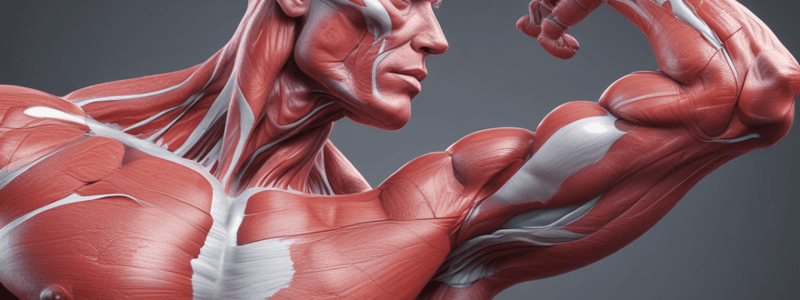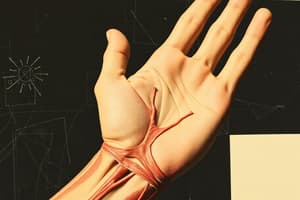Podcast
Questions and Answers
What type of muscle is characterized by having long, thin lines?
What type of muscle is characterized by having long, thin lines?
- Smooth muscle
- Cardiac muscle (correct)
- Visceral muscle
- Skeletal muscle
Which type of muscle is under autonomic control and is found in the walls of the GI tract and arteries?
Which type of muscle is under autonomic control and is found in the walls of the GI tract and arteries?
- Smooth muscle (correct)
- Visceral muscle
- Skeletal muscle
- Cardiac muscle
What is the function of skeletal muscles in the body?
What is the function of skeletal muscles in the body?
- For locomotion and maintaining body posture (correct)
- To contract slowly with sustained movements
- To regulate the contractions of the heart muscles
- To control involuntary actions in the body
Which term refers to the attachment of a muscle that usually moves the most?
Which term refers to the attachment of a muscle that usually moves the most?
What is a common location where smooth muscles are found in the body?
What is a common location where smooth muscles are found in the body?
What kind of muscle is responsible for voluntary movements such as lifting weights or walking?
What kind of muscle is responsible for voluntary movements such as lifting weights or walking?
What is the action of the accessory nerve (CN XI)?
What is the action of the accessory nerve (CN XI)?
Which muscle is responsible for extending the carpus and is innervated by the radial nerve?
Which muscle is responsible for extending the carpus and is innervated by the radial nerve?
What is the action of the gracilis muscle?
What is the action of the gracilis muscle?
Which muscle is an example of an epaxial muscle?
Which muscle is an example of an epaxial muscle?
What is the innervation of the gastrocnemius muscle?
What is the innervation of the gastrocnemius muscle?
Which of the following is an example of a hypaxial muscle?
Which of the following is an example of a hypaxial muscle?
Which type of muscle is responsible for the slow, sustained contractions found in the walls of the gastrointestinal tract and blood vessels?
Which type of muscle is responsible for the slow, sustained contractions found in the walls of the gastrointestinal tract and blood vessels?
What is the term used to describe the attachment of a muscle that usually moves the most during a contraction?
What is the term used to describe the attachment of a muscle that usually moves the most during a contraction?
Which of the following is an example of an extrinsic muscle of the thoracic limb?
Which of the following is an example of an extrinsic muscle of the thoracic limb?
What type of muscle is described as having long, thin lines and is responsible for voluntary movements?
What type of muscle is described as having long, thin lines and is responsible for voluntary movements?
Which type of muscle is found in the wall of the heart and is responsible for the rhythmic contraction of the heart?
Which type of muscle is found in the wall of the heart and is responsible for the rhythmic contraction of the heart?
What is the term used to describe the attachment of a muscle that is usually more fixed and moves the least during a contraction?
What is the term used to describe the attachment of a muscle that is usually more fixed and moves the least during a contraction?
Which statement about the rectus abdominis muscle is correct?
Which statement about the rectus abdominis muscle is correct?
What is the action of the iliocostalis muscle?
What is the action of the iliocostalis muscle?
Which muscle is responsible for extending the tarsus and flexing the stifle?
Which muscle is responsible for extending the tarsus and flexing the stifle?
Which statement about the extensor carpi radialis muscle is false?
Which statement about the extensor carpi radialis muscle is false?
What is the innervation of the gracilis muscle?
What is the innervation of the gracilis muscle?
Which muscle is responsible for adducting the limb, extending the hip, and flexing the stifle?
Which muscle is responsible for adducting the limb, extending the hip, and flexing the stifle?
Which type of muscle is responsible for slow, sustained contractions in the walls of the gastrointestinal tract and blood vessels?
Which type of muscle is responsible for slow, sustained contractions in the walls of the gastrointestinal tract and blood vessels?
What is the term used to describe the attachment of a muscle that usually moves the most during a contraction?
What is the term used to describe the attachment of a muscle that usually moves the most during a contraction?
Which muscle is used for locomotion, movement of body parts relative to each other, and maintaining body posture?
Which muscle is used for locomotion, movement of body parts relative to each other, and maintaining body posture?
What is the main characteristic of striated muscles?
What is the main characteristic of striated muscles?
Which term refers to the attachment of a muscle that usually moves the least during contraction?
Which term refers to the attachment of a muscle that usually moves the least during contraction?
Where are smooth muscles typically found in the body?
Where are smooth muscles typically found in the body?
What is the action of the extensor carpi radialis muscle?
What is the action of the extensor carpi radialis muscle?
Which muscle is an example of a hypaxial muscle?
Which muscle is an example of a hypaxial muscle?
What is the innervation of the gracilis muscle?
What is the innervation of the gracilis muscle?
What is the action of the gastrocnemius muscle?
What is the action of the gastrocnemius muscle?
Which muscle is responsible for extending the shoulder?
Which muscle is responsible for extending the shoulder?
What is the innervation of the muscle responsible for extending the shoulder?
What is the innervation of the muscle responsible for extending the shoulder?
Which type of muscle is responsible for the rhythmic contraction of the heart?
Which type of muscle is responsible for the rhythmic contraction of the heart?
What is the main characteristic of striated muscles?
What is the main characteristic of striated muscles?
Which muscle is responsible for extending the shoulder?
Which muscle is responsible for extending the shoulder?
What is the term used to describe the attachment of a muscle that usually moves the least during a contraction?
What is the term used to describe the attachment of a muscle that usually moves the least during a contraction?
Which type of muscle is characterized by slow, sustained contractions and is found in the walls of the gastrointestinal tract and blood vessels?
Which type of muscle is characterized by slow, sustained contractions and is found in the walls of the gastrointestinal tract and blood vessels?
Which muscle is an example of an extrinsic muscle of the thoracic limb?
Which muscle is an example of an extrinsic muscle of the thoracic limb?
Which muscle extends the tarsus and flexes the stifle?
Which muscle extends the tarsus and flexes the stifle?
What is the main function of the hypaxial muscles?
What is the main function of the hypaxial muscles?
Where is the origin of the rectus abdominis muscle?
Where is the origin of the rectus abdominis muscle?
Which nerve innervates the adductor, hip extensor, and stifle flexor muscle?
Which nerve innervates the adductor, hip extensor, and stifle flexor muscle?
What is the action of the epaxial muscle iliocostalis?
What is the action of the epaxial muscle iliocostalis?
Which muscle is an extensor of the carpus?
Which muscle is an extensor of the carpus?



